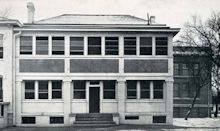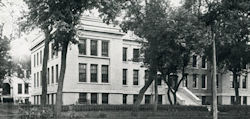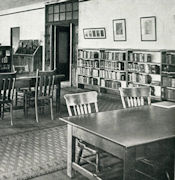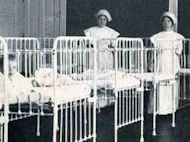Search the Blog
Categories
- Books & Reading
- Broadband Buzz
- Census
- Education & Training
- General
- Grants
- Information Resources
- Library Management
- Nebraska Center for the Book
- Nebraska Memories
- Now hiring @ your library
- Preservation
- Pretty Sweet Tech
- Programming
- Public Library Boards of Trustees
- Public Relations
- Talking Book & Braille Service (TBBS)
- Technology
- Uncategorized
- What's Up Doc / Govdocs
- Youth Services
Archives
Subscribe
Tag Archives: Nebraska Orthopedic Hospital
Caring for the Children
Nebraska Memories Archive: Nebraska Orthopedic Hospital
If you lived in a small rural town in the early 1900s, would you expect your local physician to be able to handle a case of Pott’s disease or a cleft palate? In 1905, the Nebraska Legislature believed children with deformities needed extra help and funded what was first known as the Nebraska State Hospital for Crippled, Ruptured and Deformed Children but soon became the Nebraska Orthopedic Hospital. As reported in the Biennial Report of The Nebraska Orthopedic Hospital for the period ending November 30, 1908, the hospital was established “by act of the Legislature … to provide hospital care for the crippled and deformed of this state who by such hospital treatment might be converted from wards of the municipalities or counties from which they came into individuals who in one way or another might become self-sustaining and independent.” As further biennial reports show, the patients were not all children.
Half of the $10,000 budget for the first year was used to remodel the boys’ dormitory on the campus of the Home for the Friendless. The hospital then opened for patients on October 1, 1905. The first year’s report to the governor, while describing its work with 106 patients, outlines the problems of not having a newly built hospital with all the facilities needed to treat and rehabilitate patients.
In 1908, the Lincoln City Directory lists the hospital’s address as 2129 S. 11th Street and directs visitors to take the S. 10th Street streetcar. No matter how patients arrived, they came from all parts of the state, including Sioux County in the farthest northwest corner.
 Over the next few years, the hospital took over additional buildings on the campus and extensions to the buildings were added, like the sleeping porches at right. Fresh air was considered important in recuperation, and without air conditioning, sleeping quarters with as many windows as possible made things more comfortable. As a number of the patients stayed for an extended period of time, various services needed to be provided such as a teacher to school classes and a gymnasium for physical training.
Over the next few years, the hospital took over additional buildings on the campus and extensions to the buildings were added, like the sleeping porches at right. Fresh air was considered important in recuperation, and without air conditioning, sleeping quarters with as many windows as possible made things more comfortable. As a number of the patients stayed for an extended period of time, various services needed to be provided such as a teacher to school classes and a gymnasium for physical training.
 By 1915, the hospital had its new building (shown at left) at 1041 South Street, a block away from the old one. According to the biennial report of 1916, this building included “new and modern office rooms, library, reception rooms, dining rooms, school rooms, laboratory, surgical department complete, and three wards with a capacity of forty beds. … the different floors communicate by inclines instead of stairways.” But the report also includes recommendations for further updates of the other buildings.
By 1915, the hospital had its new building (shown at left) at 1041 South Street, a block away from the old one. According to the biennial report of 1916, this building included “new and modern office rooms, library, reception rooms, dining rooms, school rooms, laboratory, surgical department complete, and three wards with a capacity of forty beds. … the different floors communicate by inclines instead of stairways.” But the report also includes recommendations for further updates of the other buildings.
 The State Library Commission was in charge of furnishing the new library at right, as well as stocking it with materials and supervising it. The library served both patients and employees. Students of the nursing school established at the hospital would have found many useful materials here. The school started in 1906, provided two years of training, following which some graduates went on to study for higher degrees. The students provided extra help with nursing duties and probably cut down on salaries that would have been paid to full-time staff.
The State Library Commission was in charge of furnishing the new library at right, as well as stocking it with materials and supervising it. The library served both patients and employees. Students of the nursing school established at the hospital would have found many useful materials here. The school started in 1906, provided two years of training, following which some graduates went on to study for higher degrees. The students provided extra help with nursing duties and probably cut down on salaries that would have been paid to full-time staff.
 The children’s ward at left looks rather spartan but was probably very easy to keep clean. Patients didn’t necessarily stay in the wards all the time. In addition to fresh air, the doctor’s also promoted the benefits of sunshine and activity. Vocational training was encouraged for those who could manage it. Visitors were permitted for a few hours every day. And the entertainment was provided, especially in later years. For example, in the 1950s, Jock Mahoney, an actor, stuntman, and former stepfather of actress Sally Field, visited with patients in the hospital.
The children’s ward at left looks rather spartan but was probably very easy to keep clean. Patients didn’t necessarily stay in the wards all the time. In addition to fresh air, the doctor’s also promoted the benefits of sunshine and activity. Vocational training was encouraged for those who could manage it. Visitors were permitted for a few hours every day. And the entertainment was provided, especially in later years. For example, in the 1950s, Jock Mahoney, an actor, stuntman, and former stepfather of actress Sally Field, visited with patients in the hospital.
The hospital continued to add buildings and make improvements over the years. In the 1920s a cottage was built for the superintendent, and a separate dormitory was built for the nurses. A dental department was added and the physiotherapy equipment expanded in the 1930s.
Although the hospital admitted and treated 1,587 patients in the 1970-1971 biennium, the 1971 Legislature decided to accept the recommendation of a 1968 study which said the hospital should be closed.
Visit Nebraska Memories to search for or browse through many more historical images digitized from photographs, negatives, postcards, maps, lantern slides, books and other materials.
Nebraska Memories is a cooperative project to digitize Nebraska-related historical and cultural heritage materials and make them available to researchers of all ages via the Internet. Nebraska Memories is brought to you by the Nebraska Library Commission. If your institution is interested in participating in Nebraska Memories, see http://nlc.nebraska.gov/nebraskamemories/participation.aspx for more information, contact Devra Dragos, Technology & Access Services Director.
Posted in Nebraska Memories
Tagged Archive, free, Nebraska, Nebraska Memories, Nebraska Orthopedic Hospital, NLC Blog
Leave a comment

